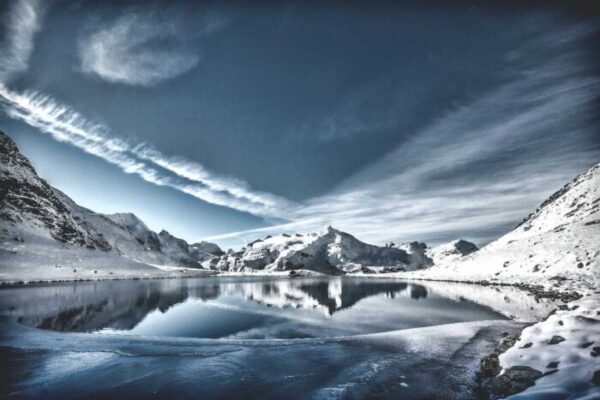Does it snow in New Zealand? The answer is YES.
But only seldom, and not when or where you expect it to.
When contrasted to most other countries, the seasons in New Zealand are reversed.
Summer is winter and winter is summer in New Zealand.
In this article, I’ll answer in detail the question “does it snow in New Zealand?”
Let’s get started.

As previously stated, YES, it does snow in New Zealand.
Snowfall in New Zealand varies by geography, with mountainous parts (Central Plateau & Southern Alps) experiencing the most snow and coastal regions having none to barely any.
Let’s talk quickly about New Zealand, which you should know about if you plan to visit the country.
Table of Contents
Overview of New Zealand
New Zealand is an island nation located in the Pacific Ocean’s southwest.
The island’s total surface of 268,021 square kilometers is divided between two landmasses, the North and South Islands.
The country has a lot to offer travelers, from beautiful beaches to rocky mountain ranges, but many have always asked the question, “does it snow in New Zealand?”
Because of its diversified topography, New Zealand has a unique climate.
Winters on the North Island are mild and moist, with temperatures ranging from 50 degrees Fahrenheit (10 degrees Celsius) to 60.8 degrees Fahrenheit (16 degrees Celsius).
Winter temperatures in the South Islands range from 44.6 degrees Fahrenheit (70 degrees Celsius) to -53.6 degrees Fahrenheit (12 degrees Celsius).
The southern portions of New Zealand are hit by substantial snowfall from June to August, accumulating to depths of 23.6 inches (600 millimeters).
Does it Snow in New Zealand? The Climate of New Zealand
The climate of New Zealand is varied, ranging from warm subtropical in the far north to cool temperate in the extreme south, with harsh alpine conditions in the mountainous parts.
Mountain ranges that run the length of New Zealand act as a barrier to the prevailing westerly winds.
The ranges divide the country into starkly distinct temperature zones.
The West Coast of the South Island is New Zealand’s wettest region.
On the other hand, the area east of the Alps, just over 100 kilometers away, is the driest.
The majority of New Zealand receives between 600 and 1600 mm of rain per year.
Winter has more rainfall than summer in the northern and central parts of New Zealand, whilst winter has the least rainfall in the southern portion of the country.
The average yearly temperature in New Zealand ranges from 10°C in the south to 16°C in the north.
July is normally the coldest month, and January or February is usually the hottest.
Summer and winter temperatures vary relatively little in New Zealand, though inland and to the east of the ranges, the variance is higher (up to 14°C).
Temperatures also decline by around 0.7°C for every 100 meters of elevation.
The majority of snow in New Zealand accumulates in the mountains.
Snow infrequently falls in the coastal sections of the North Island and west of the South Island, while snow may fall in the east and south of the South Island in winter.
Frosty conditions can form throughout New Zealand, although they are most common on cold nights with clear skies and no wind.
Areas Where it Does Snow in New Zealand

Snowfall is most common in the South Island during winter, while mountains such as Mount Cook and the Southern Alps are frequently snow-capped all year.
We’ll look at the months with the biggest chance of snow.
When Does it Snow in New Zealand?
June
In New Zealand, June is the first month of winter.
Temperatures on the South Island range from 33.8 degrees Fahrenheit (1 degree Celsius) to 53 degrees Fahrenheit (12 degrees Celsius), while temperatures on the North Island can drop below 4 degrees Fahrenheit.
Average low temperatures in Alexandra are 27.7 degrees Fahrenheit (-2.4 degrees Celsius).
During this month, it snows extensively, with snowfall totaling more than 0.5 inches (12.7 millimeters).
Snow falls for 2.7 days in Queenstown, with total snowfall reaching 1.61 inches (41 millimeters).
Temperatures in the North Island drop to 33.3 degrees Fahrenheit (0.7 degrees Celsius), and areas such as Mount Ruapehu top are blanketed in snow.
July
July is New Zealand’s coldest month.
Temperatures drop even farther in regions like Queensland, where the average low is 27.7 degrees Fahrenheit (-2.4 degrees Celsius).
The frigid temperatures bring with them a surge in snowfall.
Snow builds up to a depth of 2.01 inches (51 millimeters) after falling for 3.8 days.
Cities in the north, such as Wellington, experienced average lows of 32 degrees Fahrenheit (0 degrees Celsius).
August
In New Zealand, August marks the end of winter.
As the country enters the spring season, temperatures tend to rise.
The lowest recorded temperature is 28.8 degrees Fahrenheit (-1.8 degrees Celsius).
Snow falls for fewer days in August than in July, with 2.4 days recorded.
The total snowfall for the month is 1.77 inches (45 millimeters).
Wellington’s average temperature ranges between 52.5 degrees Fahrenheit (11.4 degrees Celsius) and 48.2 degrees Fahrenheit (9 degrees Celsius).
So, Where Does It Snow in New Zealand?
Does it Snow in Wellington, New Zealand?
There is NO.
Wellington is New Zealand’s capital city. It is located at an elevation of 1624 feet (495 meters) above sea level.
Wellington has a temperate maritime climate, with winter temperatures averaging 47.5 degrees Fahrenheit (8.6 degrees Celsius).
Because of the warm temperatures and low elevation, it hardly snows in Wellington.
Does it Snow in Canterbury, New Zealand?
The answer is YES, it does snow in Canterbury.
Canterbury ranks as one of the coldest areas in New Zealand.
It has a land size of 44,508 square kilometers and is situated in the central-eastern region of South Island.
Canterbury has an estimated population of 645,900 people.
From June through September, this region receives an average of 0.51 inches (13 millimeters) of snow.
July and June are the coolest months in this region.
Does it Snow in Queenstown, New Zealand?
The answer is YES, it does snow in Queenstown.
Queenstown is a resort city located in New Zealand’s South Island’s southwest.
The town is located in a mountainous environment at an elevation of 310 meters above sea level and encompasses an area of 8,704 square kilometers.
It has an oceanic climate with cold winters and temperatures that frequently drop below freezing.
From March through November, it regularly snows in Queenstown.
Each year, areas receive up to 8.78 inches (223 millimeters) of snowfall.
Ski Resorts in New Zealand

Having answered the question “does it snow in New Zealand ”, let’s look at the ski resorts in New Zealand for winter lovers.
New Zealand is one of the most renowned winter sports vacation destinations.
New Zealand is a winter wonderland due to its magnificent environment and endless slopes of snow suited for all skiing skills.
It only makes sense that it has some world-class skiing resorts to appeal to the hordes of snow enthusiasts who visit the country each year.
Here are some of New Zealand’s greatest ski resorts.
Coronet Peak Ski Resort
Coronet Peak is a ski resort in Otago, New Zealand.
It has 40 kilometers of ski and snowboard slopes.
The winter sports area is located at elevations ranging from 1229 to 1649 meters above sea level.
To transfer tourists, four cable lifts totaling 4.4 kilometers of lift length and carrying 8,200 passengers per hour are used.
The slope is broken down into three routes based on difficulty level.
The easiest route is 8 kilometers long, the intermediate course is 16 kilometers long, and the most difficult route is 16 kilometers long.
From mid-June through late September, Coronet Peak is open.
Mt. Hutt Ski Resort
Mt. Hutt ski resort is situated on 364 hectares of land in the Canterbury region of New Zealand’s South Island.
This resort is best suited to intermediate to advanced skiers.
It consists of 40 kilometers of ski and snowboard slopes located between 1,438 and 2,086 meters above sea level.
Three ski lifts serve the resort, carrying 6,900 passengers per hour over a total lift length of 2.9 kilometers.
It is open from the middle of June through the middle of October.
Cardrona Ski Resort
Cardrona ski resort is situated in Otago, South Island, with elevations ranging from 1,260 to 1,860 meters above sea level.
It has 40 kilometers of ski and snowboard slopes.
The resort is accessible by five lifts that span 4.5 kilometers and carry 9950 passengers each hour.
From late June to early October, the ski resort is open.
Final Thoughts on the Question: “Does It Snow in New Zealand?”
Does it snow in New Zealand? The answer is YES.
The climate and geography of New Zealand are both diverse, with sun-drenched beaches on the North Island and harsh mountain ranges for winter sports on the South Island.
The weather in New Zealand is moderate, which means that temperatures can vary from summer to winter and from island to island.
The frequency and quantity of snowfall in New Zealand varies by region.
Like the snowfall in Australia, where some areas get a lot of snow and others only get a small dusting.
So, if you’re planning a trip to New Zealand, consider the seasons and decide which things you’d like to do before you arrive.
Frequently Asked Questions
New Zealand’s winters normally last from June to August. The weather in New Zealand during the winter might vary depending on where you are in the country. Winters in the North Island are typically mild, with temperatures ranging from 8°C to 15°C. Winters on the South Island are often colder and more unpredictable, with temperatures ranging from -2°C to 10°C. Snowfall is not uncommon in the mountains, but it is uncommon in the lowlands in most regions.
YES, winters are fun in New Zealand. Winter is an excellent season to visit New Zealand for nature and adventure enthusiasts, as the beauty of the country is heightened by snow-capped mountains and a variety of winter sports.
Snow normally occurs from June through October, though cold blasts can occur outside of this time frame. The majority of New Zealand’s snow falls in mountainous locations, such as the Central Plateau in the North Island and the Southern Alps in the South Island.
This is subjective and depends on personal preferences and skiing experience. New Zealand generally has better quality snow due to its colder temperatures and higher altitude ski resorts. Australia, on the other hand, has a longer ski season and larger ski resorts with more amenities and après ski activities.
YES, New Zealand has all four seasons, although the timing and weather patterns may differ from other parts of the world. They are spring, summer, autumn (or fall), and winter.
Snow is not common in most parts of New Zealand, as the country experiences a temperate maritime climate with mild temperatures throughout the year. Snow falls on the South Island of New Zealand and at higher elevations on the North Island. At sea level in the North Island, it is extremely unusual. Snowfall is more prevalent inland in both main islands, while snowfall to sea level occurs once or twice per year on average in the central and southern South Island.

I am Monica, the enthusiastic explorer behind funthingsworld.com. With a degree in Leisure and Recreation Management and over 5 years of diving into thrilling adventures, I’ve made it my mission to uncover the best and most exciting activities around the globe.
Stay connected and get a sneak peek into my adventures on Instagram: @mongjerde











